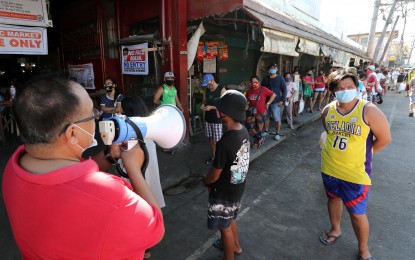
REOPENING ECONOMY. Marketgoers practice physical distancing with the help of a barangay personnel in this undated photo as the government tries to reopen the economy. Malacañang on Thursday (Dec. 17, 2020) said fewer Filipinos are experiencing involuntary hunger due to efforts to reopen the economy amid the coronavirus disease 2019 pandemic. (File photo)
MANILA – Fewer Filipinos are experiencing involuntary hunger due to efforts to reopen the economy amid the coronavirus disease 2019 (Covid-19) pandemic, Malacañang said Thursday.
Presidential Spokesperson Harry Roque made this statement after a Social Weather Stations (SWS) survey from Nov. 21 to 25, found that 16 percent or an estimated 4 million families experienced involuntary hunger at least once in the past three months.
The SWS survey said the November 2020 hunger rate is 15 points below the record-high 30.7 percent (around 7.6 million families) in September 2020.
However, it is double the pre-pandemic 8.8 percent (2.1 million families) of families in December 2019.
In a Palace press briefing, Roque welcomed this figure but admitted that it was still sad to know that millions of Filipinos remain hungry.
“Malungkot pa rin po ‘yan dahil alam natin napakadami nang nagugutom pa. Pero ito nga po ay kalahati noong hunger rate na na-rehistro noong Setyembre 2020 (It’s still sad because we know that many are still hungry, but this figure is half of the hunger rate registered last September 2020),” he said.
Roque attributed the eased hunger rate to efforts to reopen the economy but warned that Metro Manila and other areas in the country could still revert to stricter community quarantine if Covid-19 cases rise.
“Yung pagbawas po ng kalahati sa hunger rate, ito po’y resulta ng unti-unting nating pagbubukas ng ating ekonomiya, pero may banta nga po na itong unti-unting magbubukas ay baka maantala kung dadami po ang kaso ng Covid (The easing of the hunger rate in half is the result of slowly opening the economy, but slowly opening the economy could also be hindered if cases of Covid increase) So the best way to celebrate Christmas po if you really love your family, iwasan magkasakit po (avoid getting sick),” he said.
According to the SWS survey, the average hunger rate for the full-year 2020 is a new record 21.1 percent of families. It surpasses the previous record of 19.9 percent in 2011 and 2012, and is double the average 9.3 percent for 2019.
The survey showed that Metro Manila now has the highest incidence of Hunger at 23.3 percent (780,000 families), followed by Mindanao at 16.0 percent (909,000 families), Balance Luzon at 14.4 percent (1.6 million families), and the Visayas at 14.3 percent (674,000 families).
In September 2020, hunger was at 40.7 percent (1.9 million families) in the Visayas, 37.5 percent (2.1 million families) in Mindanao, 28.2 percent (941,000 families) in Metro Manila, and 23.8 percent (2.6 million families) in Balance Luzon.
Meanwhile, nationwide, moderate hunger and severe hunger are 12.6 percent and 3.4 percent, respectively, in November 2020 compared to 22.0 percent and 8.7 percent in September 2020.
Moderate hunger and severe hunger in Metro Manila reached 16.7 percent and 6.7 percent, respectively, in November 2020 compared to 20.1 percent and 8.1 percent in September 2020.
In Balance Luzon, moderate hunger and severe hunger are 11.6 percent and 2.8 percent, respectively, in November 2020 compared to 18.6 percent and 5.2 percent in September 2020.
Moderate hunger and severe hunger in the Visayas reached 10.0 percent and 4.3 percent, respectively, in November 2020 compared to 25.7 percent and 15.0 percent in September 2020.
In Mindanao, moderate hunger and severe hunger are 14.3 percent and 1.7 percent, respectively, in November 2020 compared to 26.9 percent and 10.6 percent in September 2020.
The November 2020 survey, the first in 2020 to measure self-rated poverty, found 48 percent of families rating themselves as poor, 36 percent feeling borderline poor, and only 16 percent feeling not poor.
It also found 31 percent of families rating themselves as food-poor, 47 percent feeling borderline food-poor, and 22 percent feeling not food-poor
From December 2019 to November 2020, overall hunger increased among the self-rated poor, from 12.8 percent to 21.7 percent. It also rose among the non-poor over the same period, up from 4.1 percent to 10.6 percent.
Overall hunger also rose among the self-rated food-poor, up from 15.5 percent in December 2019 to 28.1 percent in November 2020. It rose among the non-food-poor, up from 5.1 percent to 10.5 percent. (PNA)
